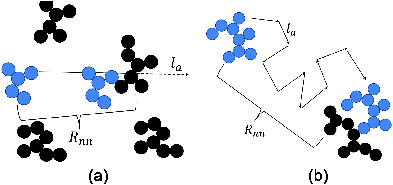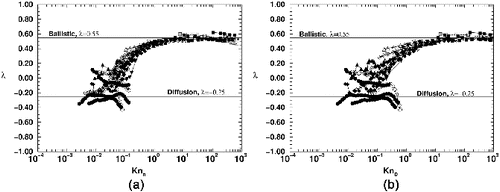Figures & data
FIG. 1. (a) Illustration of a ballistic collision where the light shaded cluster does not make one full persistence length before colliding with its neighbor. (b) Illustration of a diffusive collision where the light shaded cluster makes several persistence lengths before colliding.

FIG. 2. Inverse cluster count versus t + t0. t0 was found from EquationEquation (28)[28] . The lower dashed guide line has a kinetic exponent z = 0.80 − 0.88 and the upper guide line has z = 2.2. The points where Knn = 1 are marked and noted in the legend. The points where Knd = 1 are noted as stars in their respective runs. (a) Monte Carlo simulation at fv = 10−4; (b) Brownian Dynamics simulation at fv = 10−4; (c) Monte Carlo simulation at fv = 10−3; (d) Brownian Dynamics simulation at fv = 10−3; (e) Monte Carlo simulation at fv = 10−2; (f) Brownian Dynamics simulation at fv = 10−2. Notice that in (e) and (f) the Epstein diffusion exponent is z = 0.88 as expected when in the cluster dense regime. Also of note in (e) and (f) the trend has upward curvature do to the onset of gelation.
![FIG. 2. Inverse cluster count versus t + t0. t0 was found from EquationEquation (28)[28] . The lower dashed guide line has a kinetic exponent z = 0.80 − 0.88 and the upper guide line has z = 2.2. The points where Knn = 1 are marked and noted in the legend. The points where Knd = 1 are noted as stars in their respective runs. (a) Monte Carlo simulation at fv = 10−4; (b) Brownian Dynamics simulation at fv = 10−4; (c) Monte Carlo simulation at fv = 10−3; (d) Brownian Dynamics simulation at fv = 10−3; (e) Monte Carlo simulation at fv = 10−2; (f) Brownian Dynamics simulation at fv = 10−2. Notice that in (e) and (f) the Epstein diffusion exponent is z = 0.88 as expected when in the cluster dense regime. Also of note in (e) and (f) the trend has upward curvature do to the onset of gelation.](/cms/asset/e07a2f28-3718-44ae-842b-d7f1abf1c841/uast_a_922677_f0002_b.gif)
FIG. 3. (a) Aggregation kernel homogeneity λ versus nearest neighbor Knudsen number Knn for all Monte Carlo and Brownian Dynamic simulations. (b) The diffusive Knudsen number KnD versus homogeneity λ for all Monte Carlo and Brownian Dynamic simulations. Both measurements show similar behavior and provide a means of detecting the crossover.

FIG. 4. Aggregate size distribution from Brownian Dynamics with l0 = 50 and fv = 10−3. Lines represent fits from EquationEquation (33)[33] . The system starts off with ballistic λ then enters an intermediate regime during the crossover and finally at late time and small Knn reaches a diffusive λ. (a) Size distribution from Monte Carlo simulations; (b) size distribution from Brownian Dynamics simulations; (c) rescaled data from (a), here the homogeneity λ transition from ballistic to diffusive can be clearly seen. The system starts with ballistic homogeneity of λ = 0.55 ± 0.1 then changes to λ = −0.3 ± 0.2, consistent to other values of λ reported for Epstein diffusion. (d) Rescaled data from (b), the system starts with ballistic homogeneity of λ = 0.55 ± 0.1 then changes to λ = −0.40 ± 0.2, consistent with Epstein diffusion.
![FIG. 4. Aggregate size distribution from Brownian Dynamics with l0 = 50 and fv = 10−3. Lines represent fits from EquationEquation (33)[33] . The system starts off with ballistic λ then enters an intermediate regime during the crossover and finally at late time and small Knn reaches a diffusive λ. (a) Size distribution from Monte Carlo simulations; (b) size distribution from Brownian Dynamics simulations; (c) rescaled data from (a), here the homogeneity λ transition from ballistic to diffusive can be clearly seen. The system starts with ballistic homogeneity of λ = 0.55 ± 0.1 then changes to λ = −0.3 ± 0.2, consistent to other values of λ reported for Epstein diffusion. (d) Rescaled data from (b), the system starts with ballistic homogeneity of λ = 0.55 ± 0.1 then changes to λ = −0.40 ± 0.2, consistent with Epstein diffusion.](/cms/asset/ca063c39-c4c1-47d9-844d-e9008fed6489/uast_a_922677_f0004_b.gif)
